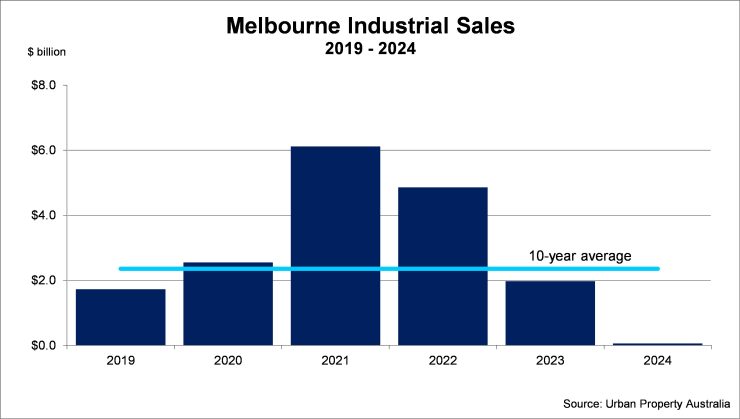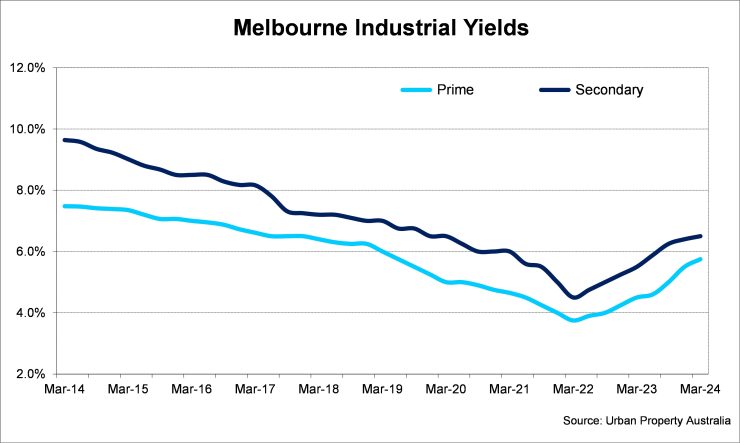Q1 2024 – Melbourne Industrial Market
April 26th 2024 | , Urban Property Australia
- Based on current transactional volume levels, sales across the Melbourne industrial is likely to its lowest level since 2010 with only $62 million of Melbourne industrial sales recorded in 2024 to date;
- Vacant industrial space across the Melbourne market continues to remain very low, as the growth of e-commerce has driven tenant demand with industrial vacancy rate currently standing at 1.4%;
- While the level of speculative construction is easing, new industrial supply in the Melbourne industrial market is forecast to reach 1.2 million square metres in 2024.
Industrial Market Summary
Transactional activity in Melbourne’s industrial continues to decline. Having peaked in 2021 with more than $6 billion of industrial property sold, only $62 million of Melbourne industrial sales has been recorded in 2024 to date. Based on current transactional volume levels, sales across the Melbourne industrial is likely to its lowest level since 2010. Boosted by the growing penetration of e-commerce and a growing importance of supply chain efficiencies, transport and logistics the largest sector taking up industrial space followed by retailers and wholesale trade.

Sales Volume / Yields
Transactional activity in Melbourne’s industrial continues to decline. Having peaked in 2021 with more than $6 billion of industrial property sold, only $62 million of Melbourne industrial sales has been recorded in 2024 to date. Based on current transactional volume levels, sales across the Melbourne industrial is likely to its lowest level since 2010. As a result of pressure from investor redemptions, institutions have largely been absent from purchasing additional properties with this year dominated by private investors, both local and offshore based. Similar to other commercial property markets, the lack of transactional activity has resulted in yields continue to soften as the disconnect between vendors and potential purchasers remaining. Urban Property research estimate that average prime industrial yields sit at 5.75% with average secondary yields moving out to 6.50% over the 12 months to March 2024, albeit they have stabilised in 2024.

New Supply / Land Values
While the level of speculative construction is easing, new industrial supply in the Melbourne industrial market is forecast to reach 1.2 million square metres in 2024 and is projected to surpass the long-term average for a six consecutive year. The bulk of the new supply currently under construction in the Melbourne industrial market is located in the Western region. Having increased substantially in recent years, average industrial land values have remained steady over the past year, which have been supported by rising rents despite yields softening. Industrial land values in Melbourne key industrial markets average $850/sqm with industrial land values in the City Fringe market sit around $2,000/sqm.
Tenant Demand
Industrial leasing activity in the Melbourne industrial market has made a steady start to the year, with similar to recent years, transport and logistics the largest sector taking up industrial space. Boosted by the growing penetration of e-commerce and a growing importance of supply chain efficiencies, retailers and wholesale trade also remain prominent highlighted by Amazon’s commitment to its new 200,000sqm facility. The focus of the tenant demand in 2024 to date has been the Western region according to Urban Property Australia research.
Vacancy / Rents
Vacant industrial space across the Melbourne market continues to remain very low, as the growth of e-commerce has driven tenant demand outpacing new supply. Urban Property Australia research estimates that Melbourne industrial vacancy rate currently stands at 1.4% as at March 2024, a slight increase since January with the North and East vacancy rates at 1%. Elsewhere, the vacancy rate of the South East region is 1.2% and the Western region standing at 1.5%.
While Melbourne industrial rents continue to increase, rates of growth have moderated by the level of new supply which was delivered to the market over the past 12 months. Prime industrial rents have grown on average by 10% over the 12 months to March 2024 with secondary rents having increased by 8% as tenants struggle to source accommodation of all qualities. Prime rental growth was led by the South Eastern precinct given the limited pipeline of new supply in the region. Urban Property Australia expects that while rents will continue to increase, the rate of rental increases will reflect the amount of supply to various regions as tenants seek facilities to accommodate supply chain requirements.
Copyright © 2024 by Urban Property Australia All rights reserved. No part of this publication may be reproduced in any form, by microfilm, xerography, electronically or otherwise, or incorporated into any information retrieval system, without the written permission of the copyright owner.



